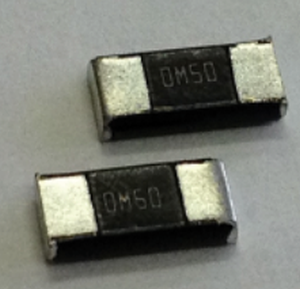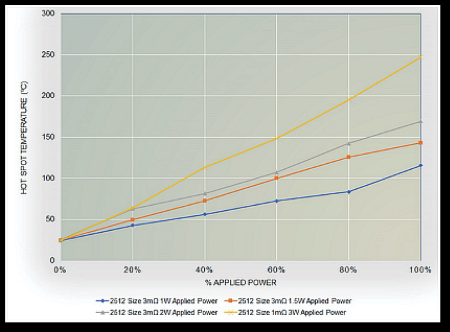Shrinking component sizes have complicated the task of ensuring temperatures stay below their allowable maximum.
Kory Schroeder • Stackpole Electronics Inc.
Electronic components of all types continue to shrink in size. In response, resistor manufacturers are devising resistors with higher power ratings but which come in commonly used sizes. Of course, when more power gets dissipated in a smaller package, it is important to consider the impact on thermal issues.
Chip resistor technology is evolving rapidly. Materials used in the construction of the resistor greatly impact how quickly and efficiently the part deals with the thermal energy it generates. The amount of heat that a particular resistor can dissipate depends on the specific heat of its materials and is proportional to the mass of the material used. For example, metal alloy resistors, whether wire-wound or made with low resistance alloys for current sensing, will exhibit better thermal conduction and have more mass than similar resistors with film elements. Consequently, metal alloy resistors typically have higher power ratings.


Thermal reduction strategies vary widely in cost. Their effectiveness varies with the application and surroundings. Convection cooling from fans may be practical in some industrial applications but not in small consumer electronics. Other methods such as the use of larger solder pads, copper traces of a heavier weight, larger traces, vias through the PCB, and heat sinks are all candidates. Components that either absorb heat (transformers or large inductors) or that can’t tolerate it (certain semiconductors) must be kept away from resistors running at high power. This distancing may be tough to accomplish in designs that require small footprints. These problems may force the use of more robust semiconductors along with multiple heat reduction methods.
Similar design considerations are necessary when using downsized chip resistors. A standard 1206-size chip may work for thick-film devices requiring a quarter-watt power rating. However, high-power 0603-size chip resistors are now readily available. These reduce the overall space needed (including solder pads and traces) by 66% or more depending on manufacturer recommendations. The significance of this size savings depends on the total circuit area and other factors such as trace routing. But the size reduction can be dramatic when multiple parts are replaced in this manner.

Depending on the PCB design, replacement of multiple chip resistors with smaller high-power versions can easily add 15 to 40 degrees of heat. For high density applications, even a reasonable combination of heat reduction methods may not be enough to deal with this kind of heat rise. Thus it may not be feasible to replace numerous resistors with smaller chip-packaged versions having higher power ratings.
All in all, current trends toward compact personal electronic devices make it desirable to use smaller components. Smaller components with higher power ratings are now readily available, but the net effect of close spacing makes it tough to keep surface-mount chip resistors below their 105 to 125ºC hot-spot temperature max. Keeping components below their maximum terminal temperature ensures stable operation and longer circuit lifetime.







Leave a Reply